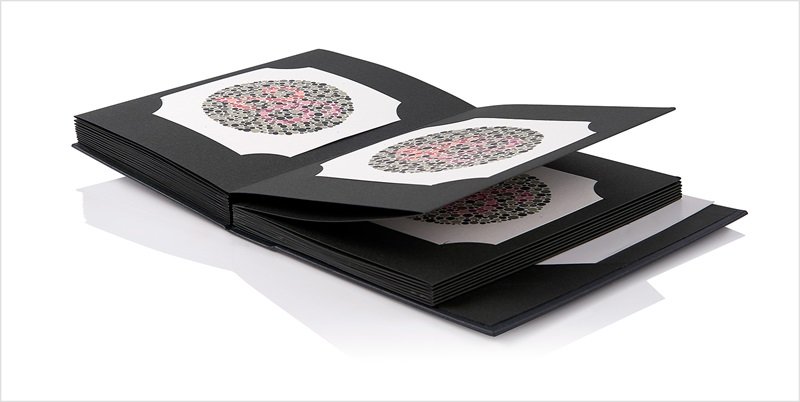The ability to see colour is important within many industries. It directly affects safety, accuracy, communication, and quality. In jobs like electricians, pilots, drivers, and healthcare workers, recognising colours is crucial. It helps avoid serious mistakes and can even save lives.
Colour blindness, or colour vision deficiency, affects approximately 1 in 12 men and 1 in 200 women. In most cases, this condition is inherited and passed down genetically, rather than developing later in life.
Despite its prevalence, many individuals remain unaware they have a colour vision deficiency, as the way we perceive colour can vary widely and often goes unnoticed.
Since people with colour blindness may not realise they see colours differently from those with typical vision, undergoing a colour blindness test is essential. Among the various methods available, the Ishihara test is the most widely used and reliable way to detect red-green colour deficiencies.
Without the ability to see colours accurately, professionals might miss important visual clues. This can increase the risk of harm to themselves or others.
What is the Ishihara test?
Colour vision deficiencies can appear in various forms and often remain undetected by those affected.
The Ishihara colour test is a vision test for the detection of red–green colour deficiencies. Dr. Shinobu Ishihara, a Japanese ophthalmologist, developed it in 1917 to identify a person's ability to accurately perceive colour.
It consists of a series of 38 plates known as Ishihara plates, which feature circles filled with coloured dots. When vision screening, testers typically use only 14 plates to detect red-green colour blindness. In clinical or workplace settings where time is limited, this is a quick way to make an assessment.
In each circle, dots of different colours and sizes create a number or shape. This is clear to people with normal colour vision. Those people with colour blindness will have difficulty distinguishing the dots.
Types of Ishihara tests
The Ishihara test was originally developed in three versions - two in Japanese and one in Arabic, to assess the colour vision of soldiers in the Imperial Japanese Army. Over time, the Arabic version gained traction and became the most widely distributed in Western countries. Since its introduction, the test has undergone several adaptations, evolving into the widely used colour blindness test we rely on today. These updates have helped standardise the Ishihara plates as a key tool in modern colour vision testing.
- Demonstration plate: The first plate, visible to everyone regardless of colour vision, to show how the test works.
- Transformation plates: Individuals with normal colour vision can only see one number. While those with colour blindness see another or nothing at all.
- Vanishing plates: Only people with normal colour vision can see the number. For those with colour blindness, it won't be visible.
- Hidden digit plates: Only people with colour blindness can see the number.
- Diagnostic plates: Used to determine the type (e.g., protanopia, deuteranopia) and severity of the colour deficiency.
Other common colour vision tests ask you to arrange colours by shade. You may also need to identify matching colours.

Ishihara Test Chart Book (38-plate Edition)
What can the Ishihara test tell you?
The Ishihara colour test primarily detects red-green colour deficiencies (protanopia and deuteranopia). Theses are the most common types of colour blindness.
They are often used to test people in jobs where seeing colours correctly is crucial. This includes pilots, electricians, and graphic designers.
The test is not as effective for finding other types of colour blindness, including blue-yellow deficiencies, known as tritanopia, and total colour blindness, called achromatopsia.
How accurate is the Ishihara test?
Experts generally consider the Ishihara test a highly accurate tool for detecting red-green colour vision deficiencies. The accuracy depends on factors such as how the test giver administers the test, the setting, and the type of colour vision problem that the test evaluates.
What is a normal score on the Ishihara test?
A normal score usually means the person can identify most or all the numbers and patterns on the plates. People with normal colour vision can see the numbers or patterns on most Ishihara plates correctly.
In clinical settings, healthcare professionals may still consider a small number of incorrect answers normal. This is especially true if they involve test plates that are more challenging or ambiguous. Usually, missing one or two plates may still fall within the normal range, depending on the test administrator's criteria.
Vision testers
In summary, colour perception improves safety, communication, emotions, and aesthetics, making it essential for how people interact with the world. At Amplivox we support the occupational health sector with vision testers that include colour vision testing.
Our vision testers provide fast and accurate vision assessments, offering essential tests for industries where accurate colour perception is crucial.
Compact and portable, our instruments also provide significant improvements in workflow and time management for general healthcare practitioners and occupational health personnel.
For more information on our vision screening devices please visit our vision testers webpage, contact our customer support team on +44 (0)1865 880 846 or email us.
References
Colour Blind Awareness, About Colour Blindness. Accessed at: https://www.colourblindawareness.org/colour-blindness/
National Eye Institue, At a glance: Color Blindness (Dec 2024). Accessed at: https://www.nei.nih.gov/learn-about-eye-health/eye-conditions-and-diseases/color-blindness
NHS, Colour vision deficiency (colour blindness) (Mar 2023). Accessed at: https://www.nhs.uk/conditions/colour-vision-deficiency/